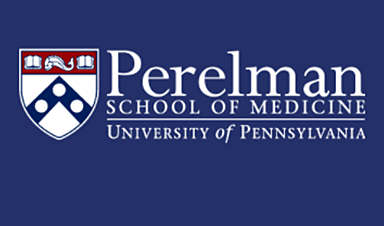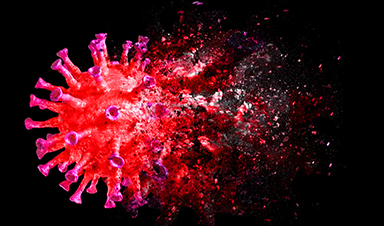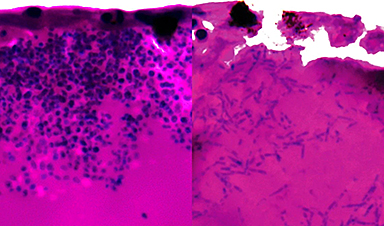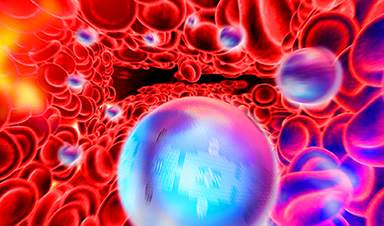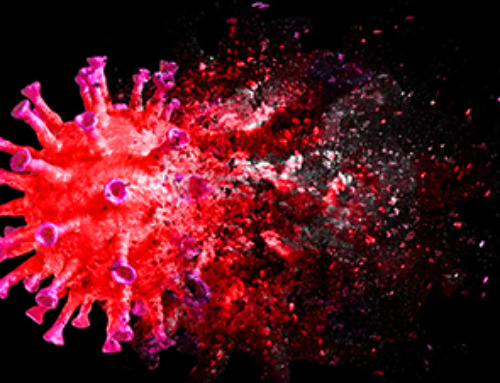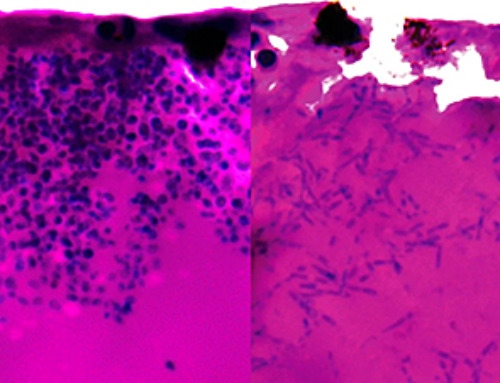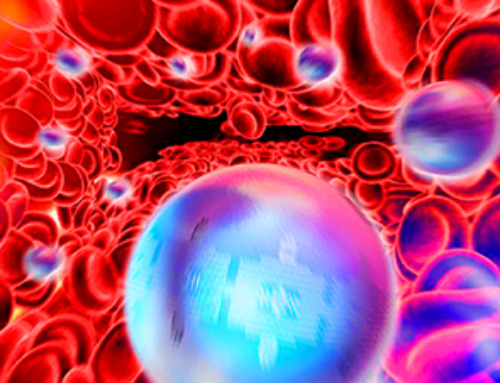Researchers at Penn Medicine have discovered a new, more effective method of preventing the body’s own proteins from treating nanomedicines like foreign invaders, by covering the nanoparticles with a coating to suppress the immune response that dampens the therapy’s effectiveness.
Nanoparticles are tiny capsules, typically engineered from proteins or fat-related molecules, that serve as delivery vehicles for certain types of treatment or vaccine—usually those containing RNA or DNA. The best-known examples of nanoparticle-delivered medicines are mRNA vaccines against COVID-19.
“It turned out to be one of those technologies that just works right away and better than anticipated,” said study co-senior author Jacob Brenner, MD, Ph.D., an associate professor of Pulmonary Medicine in the Division of Pulmonary, Allergy, and Critical Care.
The Complement Problem
Therapies based on RNA or DNA generally need delivery systems to get them through the bloodstream into target organs. Harmless viruses often have been used as carriers or “vectors” of these therapies, but nanoparticles are increasingly considered safer alternatives. Nanoparticles also can be tagged with antibodies or other molecules that make them hone in precisely on targeted tissues.
Despite its promise, nanoparticle-based medicine has been greatly limited by the complement attack problem. Circulating complement proteins treat nanoparticles as if they were bacteria, immediately coating nanoparticle surfaces and summoning large white blood cells to gobble up the “invaders.” Researchers have attempted to reduce the problem by pre-coating nanoparticles with camouflaging molecules—for example, the organic compound polyethylene glycol (PEG) attracts water molecules to form a watery, protective shell around nanoparticles. But nanoparticles camouflaged with PEG or other protective substances still draw at least some complement attack. In general, nanoparticle-based medicines that must move through the bloodstream to do their work (mRNA COVID-19 vaccines are injected into muscle, not the bloodstream) have had a very low efficiency in getting to their target organs, usually less than one percent.
Borrowing a Strategy
In the study, Brenner and Myerson and their team came up with an alternative or add-on approach to protect nanoparticles—an approach based on natural complement-inhibitor proteins that circulate in the blood, attaching to human cells to help protect them from complement attack.
The researchers found that, in lab-dish experiments, coating standard PEG-protected nanoparticles with one of these complement inhibitors, called Factor I, provided dramatically better protection from complement attack. In mice, the same strategy prolonged the half-life of standard nanoparticles in the bloodstream, allowing a much larger fraction of them to reach their targets.
“Many bacteria also coat themselves with these factors to protect against complement attack, so we decided to borrow that strategy for nanoparticles,” said co-senior author Jacob Myerson, Ph.D., a senior research scientist in the Department of Systems Pharmacology and Translational Therapeutics at Penn.
In a set of experiments in mouse models of severe inflammatory illness, the researchers also showed that attaching Factor I to nanoparticles prevents the hyper-allergic reaction that otherwise could be fatal.
Further testing will be needed before nanomedicines incorporating Factor I can be used in people, but in principle, the researchers said, attaching the complement-suppressing protein could make nanoparticles safer and more efficient as therapeutic delivery vehicles so that they could be used even in severely ill patients.
The researchers now plan to develop strategies for protecting not only nanomedicines but also medical devices, such as catheters, stents and dialysis tubing, which are similarly susceptible to complement attack. They also plan to investigate other protective proteins beside Factor I.
“We’re recognizing now that there’s a whole world of proteins that we can put on the surface of nanoparticles to defend them from immune attack,” Brenner said.
News
We May Never Know if AI Is Conscious, Says Cambridge Philosopher
As claims about conscious AI grow louder, a Cambridge philosopher argues that we lack the evidence to know whether machines can truly be conscious, let alone morally significant. A philosopher at the University of [...]
AI Helped Scientists Stop a Virus With One Tiny Change
Using AI, researchers identified one tiny molecular interaction that viruses need to infect cells. Disrupting it stopped the virus before infection could begin. Washington State University scientists have uncovered a method to interfere with a key [...]
Deadly Hospital Fungus May Finally Have a Weakness
A deadly, drug-resistant hospital fungus may finally have a weakness—and scientists think they’ve found it. Researchers have identified a genetic process that could open the door to new treatments for a dangerous fungal infection [...]
Fever-Proof Bird Flu Variant Could Fuel the Next Pandemic
Bird flu viruses present a significant risk to humans because they can continue replicating at temperatures higher than a typical fever. Fever is one of the body’s main tools for slowing or stopping viral [...]
What could the future of nanoscience look like?
Society has a lot to thank for nanoscience. From improved health monitoring to reducing the size of electronics, scientists’ ability to delve deeper and better understand chemistry at the nanoscale has opened up numerous [...]
Scientists Melt Cancer’s Hidden “Power Hubs” and Stop Tumor Growth
Researchers discovered that in a rare kidney cancer, RNA builds droplet-like hubs that act as growth control centers inside tumor cells. By engineering a molecular switch to dissolve these hubs, they were able to halt cancer [...]
Platelet-inspired nanoparticles could improve treatment of inflammatory diseases
Scientists have developed platelet-inspired nanoparticles that deliver anti-inflammatory drugs directly to brain-computer interface implants, doubling their effectiveness. Scientists have found a way to improve the performance of brain-computer interface (BCI) electrodes by delivering anti-inflammatory drugs directly [...]
After 150 years, a new chapter in cancer therapy is finally beginning
For decades, researchers have been looking for ways to destroy cancer cells in a targeted manner without further weakening the body. But for many patients whose immune system is severely impaired by chemotherapy or radiation, [...]
Older chemical libraries show promise for fighting resistant strains of COVID-19 virus
SARS‑CoV‑2, the virus that causes COVID-19, continues to mutate, with some newer strains becoming less responsive to current antiviral treatments like Paxlovid. Now, University of California San Diego scientists and an international team of [...]
Lower doses of immunotherapy for skin cancer give better results, study suggests
According to a new study, lower doses of approved immunotherapy for malignant melanoma can give better results against tumors, while reducing side effects. This is reported by researchers at Karolinska Institutet in the Journal of the National [...]
Researchers highlight five pathways through which microplastics can harm the brain
Microplastics could be fueling neurodegenerative diseases like Alzheimer's and Parkinson's, with a new study highlighting five ways microplastics can trigger inflammation and damage in the brain. More than 57 million people live with dementia, [...]
Tiny Metal Nanodots Obliterate Cancer Cells While Largely Sparing Healthy Tissue
Scientists have developed tiny metal-oxide particles that push cancer cells past their stress limits while sparing healthy tissue. An international team led by RMIT University has developed tiny particles called nanodots, crafted from a metallic compound, [...]
Gold Nanoclusters Could Supercharge Quantum Computers
Researchers found that gold “super atoms” can behave like the atoms in top-tier quantum systems—only far easier to scale. These tiny clusters can be customized at the molecular level, offering a powerful, tunable foundation [...]
A single shot of HPV vaccine may be enough to fight cervical cancer, study finds
WASHINGTON -- A single HPV vaccination appears just as effective as two doses at preventing the viral infection that causes cervical cancer, researchers reported Wednesday. HPV, or human papillomavirus, is very common and spread [...]
New technique overcomes technological barrier in 3D brain imaging
Scientists at the Swiss Light Source SLS have succeeded in mapping a piece of brain tissue in 3D at unprecedented resolution using X-rays, non-destructively. The breakthrough overcomes a long-standing technological barrier that had limited [...]
Scientists Uncover Hidden Blood Pattern in Long COVID
Researchers found persistent microclot and NET structures in Long COVID blood that may explain long-lasting symptoms. Researchers examining Long COVID have identified a structural connection between circulating microclots and neutrophil extracellular traps (NETs). The [...]
